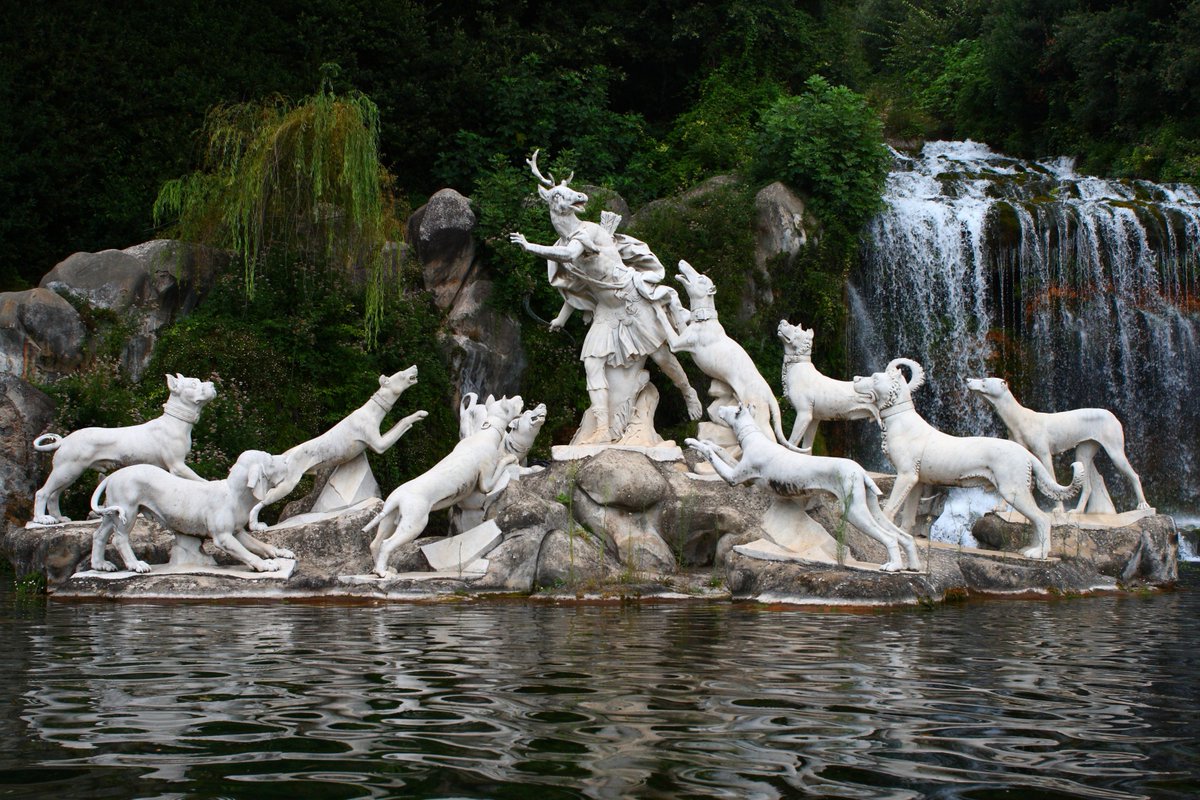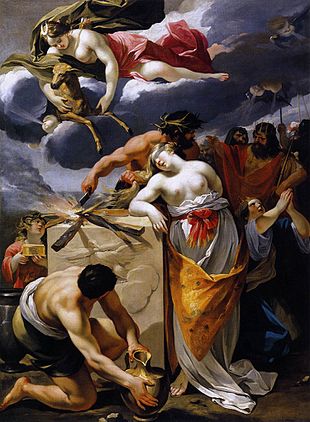Artemis
Artemis, revered as the goddess of the untamed wilderness, hunting, and protector of young girls, wielded power over both the natural realm and the mysteries of childbirth. Alongside her twin brother Apollo, she embodied the delicate balance between life and death, with Artemis safeguarding the welfare of women and girls, while Apollo watched over their male counterparts.

Residence: Mount Olympus
Symbols: Bow, arrows, stags, hunting dog, and Moon
Parents: Zeus and Leto
Siblings: Aeacus, Angelos, Aphrodite, Apollo, Ares, Athena, Dionysus, Ilithyia, Enyo, Eris, Ersa, Hebe, Helen of Troy, Hephaestus, Heracles, Hermes, Minos, Pandia, Persephone, Perseus, Rhadamanthus, the Graces, the Horae, the Litae, the Muses and the Moirae
Roman equivalent: Diana
In the realm of ancient art, Artemis was often portrayed as a youthful maiden, exuding an aura of grace and strength. Her iconic imagery featured a hunting bow in hand, accompanied by a quiver brimming with arrows, symbolizing her prowess as a skilled huntress and guardian of the wild.
Artemis’ multifaceted role extended beyond the hunt and wilderness, encompassing her divine duty as the protector of young girls until they reached the age of marriage. In this capacity, she guided them through the trials of youth and ensured their safety and well-being.
Birth
When Zeus’ wife Hera learned that Leto was pregnant with Zeus’ children, she harbored jealousy and sought to prevent Leto from finding a place to give birth. Leto wandered from land to land, facing rejection at every turn due to Hera’s influence. However, her perseverance led her to discover Delos, a unique floating island that neither belonged to the sea nor the land.

Welcomed by the hospitable shores of Delos, Leto found sanctuary and gave birth to her divine offspring there. Amidst the tranquil beauty of the island, she clung to a palm tree, finding solace and strength in its sturdy embrace as she brought forth her children into the world. This humble yet sacred birthplace became the foundation of the legend surrounding the birth of Apollo and Artemis, forever intertwined with the mystical allure of Delos.
Actaeon
Actaeon, renowned for his prowess as a hunter, unwittingly stumbled upon a sacred scene while pursuing his prey. In a stroke of ill-fated fortune, he came across the goddess Artemis and her nymphs bathing in a secluded grove. Unaware of the sanctity of the moment, Actaeon gazed upon the goddess and her attendants, violating their privacy and desecrating their sacred space.

In her wrath, Artemis, protector of the wilderness and wild animals, swiftly enacted divine retribution upon Actaeon for his trespass. With a gesture of her divine power, she transformed him into a stag, stripping away his human form and leaving him vulnerable to the elements. In a cruel twist of fate, the hounds that once obeyed his commands now turned upon him, recognizing him only as prey.
Actaeon, trapped in the body of a stag, met a gruesome end as his own hunting dogs, driven by primal instinct, tore him apart limb by limb. Thus, the proud hunter became the hunted, a cautionary tale of the consequences of crossing the boundaries set by the divine.
Adonis
In this version of the myth, a tragic cycle of vengeance unfolds among the gods and their mortal favorites. Adonis, beloved by Aphrodite, finds himself caught in the crosshairs of divine retribution as a consequence of the feud between Aphrodite and Artemis.

Artemis, still nursing the grievance of Hippolytus’ demise, orchestrated a cruel twist of fate for Adonis, whose affection for Aphrodite made him a target for the goddess of the hunt. Seeking retribution for the loss of her favored devotee, Artemis dispatched a fierce boar to carry out her vengeance upon Adonis.
The boar, a creature of primal ferocity, became the instrument of Artemis’ wrath, charging forth with relentless fury to claim the life of Adonis. In this tragic narrative, the cycle of divine vengeance perpetuates itself, with mortal lives caught in the tumultuous conflicts of the gods. Thus, the tale of Adonis serves as a somber reminder of the perilous consequences that befall those ensnared in the machinations of the divine.
Orion
The story of Orion and Artemis is indeed a tragic one, characterized by love, betrayal, and divine intervention. Orion, a skilled and mighty hunter, became the beloved companion of Artemis, the goddess of hunting and the wilderness. Despite Artemis’s affection for Orion, their relationship was not without complications.

According to some versions of the myth, Orion’s fate took a tragic turn when Apollo, Artemis’s twin brother, became jealous of their bond and sought to protect his sister’s purity. In a deceptive act, Apollo tricked Artemis into fatally striking Orion, perhaps under the guise of a hunting challenge or as a means to safeguard her maidenhood.
Artemis, unaware of the true identity of her target, grievously wounded Orion, causing his untimely demise. Upon realizing her terrible mistake and the role played by her brother in the tragedy, Artemis was consumed by sorrow and regret.
Callisto
The myth of Callisto is indeed a tragic one, involving deception, betrayal, and divine intervention. Callisto, a devoted follower of Artemis and a sworn virgin, fell victim to the advances of Zeus, who appeared to her in the guise of Artemis. As a result of this encounter, Callisto became pregnant with Zeus’s child, Arcas.

Upon discovering Callisto’s pregnancy, Artemis or Hera, or both, were outraged by her violation of chastity and transformed her into a bear as punishment. In her bear form, Callisto roamed the wilderness, unable to communicate her plight to others.
Arcas, unaware of his mother’s fate, encountered the bear during a hunting expedition and nearly killed her with his spear. However, Zeus intervened just in time to prevent the tragedy, transforming Arcas into the constellation Ursa Minor and Callisto into the constellation Ursa Major, also known as the Great Bear.
Agamemnon and Iphigenia
The story of Agamemnon and Artemis at Aulis is a tragic episode in Greek mythology. Agamemnon, in his arrogance, boasted of his hunting prowess and even dared to compare himself to the goddess Artemis. To punish him for his hubris, Artemis intervened when the Greek fleet was stranded at Aulis, preventing their departure by becalming the winds.

Calchas, the seer accompanying the Greeks, revealed that the only way to appease Artemis and allow the fleet to sail was to sacrifice Agamemnon’s daughter, Iphigenia, as a blood offering. Reluctantly, Agamemnon agreed to the sacrifice, and Iphigenia was led to the altar under the guise of being wed to Achilles.
However, just as Agamemnon was about to slay his daughter, Artemis intervened once again, taking pity on Iphigenia and sparing her life. In some versions of the myth, Artemis replaces Iphigenia with a deer at the last moment, allowing the young girl to escape her fate and be spirited away to serve as a priestess in Artemis’s temple.
Niobe
The myth of Niobe is indeed a tragic tale of hubris and divine retribution. Niobe’s arrogance and pride led her to boast of her superior fertility and challenge the mother of Apollo and Artemis, Leto. In response, Leto’s children, Apollo and Artemis, wrought swift and devastating punishment upon Niobe and her family.

Apollo, with his deadly arrows, struck down Niobe’s sons, while Artemis targeted her daughters, leaving Niobe utterly bereft and desolate. Only Chloris and her brother Amyclas were spared, either through the intervention of Leto or their own prayers for mercy.
The grief-stricken Niobe fled to Mount Sipylos, where she wept uncontrollably until she was transformed into stone. Her tears, flowing ceaselessly, formed the river Achelous, serving as a perpetual reminder of her sorrow and the consequences of her hubris.
The tragic fate of Niobe and her children serves as a cautionary tale against pride and arrogance, reminding mortals of the limits of their power in the face of the gods’ wrath.
Art









